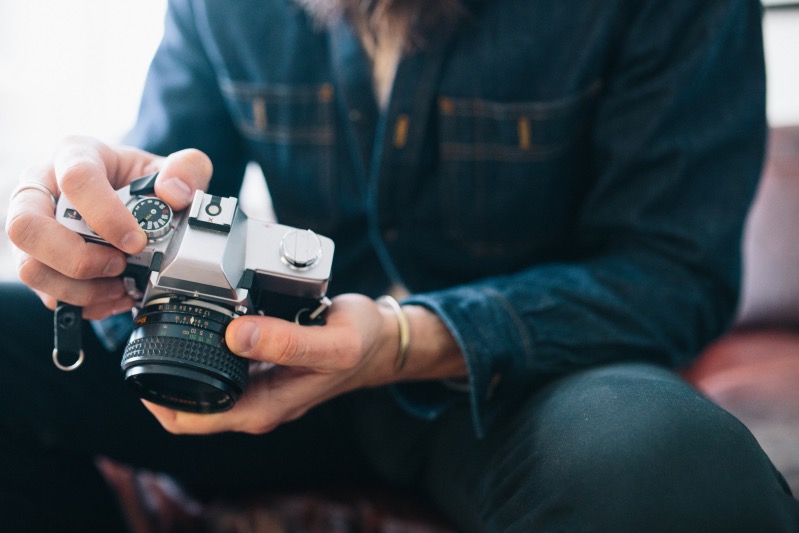Four Lessons from Hopscotch Design Festival
Kate Studwell, Former Project Manager
Article Category:
Posted on
This year marked the second annual Hopscotch Design Fest in Raleigh, NC. I’ve been lucky enough to attend both times, and have been inspired and excited by the amazing designers (including locals and those who travel from afar) who spoke at the event.
While the topics and speakers range in topics and disciplines, there always seem to be some recurring themes and lessons that I take away each year. Here’s a rundown of what I’m still mulling over after the 2015 conference.
Dedicate Yourself to A Process or Routine

Many of the speakers spoke on the topic of creating a process or routine.
Austin Kleon talked about setting aside time each day to create. Partly inspired by Julia Cameron’s Morning Pages and Jerry Seinfeld’s Calendar, Austin gets up each morning and works on a project. It may be as little as 15 minutes a day, but each day he knows that he put some time towards a project that he cares about. And eventually, that project comes to fruition.
Similarly, Maria Fabrizio wakes up early each weekday to illustrate a headline for Wordless News. She finds her work on some days to be better than others, but the routine she’s created allows her the time to create something before heading to work, and helps her keep the project from taking over her life (she doesn’t think about the project or revisit illustrations outside of the ~3 or so hours she allots herself each day).
Inspiration Surrounds Us (Or, How We Learned to Intrinsically Inspire Ourselves)

Austin spoke about the many designers who sit down to create something, only to come back with the fact (or excuse?) that they’re not feeling inspired. To him, we all have the capability to be inspired, we just need to set aside the time and space to access that part of ourselves - and we need the materials to be able to create. If you’re not inspired at first, spend time copying someone else’s work (tracing, or writing quotes, to get your fingers moving) until an idea strikes you.
Many designers at the conference talked about the genesis of their project ideas. Steve Frykholm spoke about his serious nature photgraphy hobby - although his friend called him a “serious amateur,” the photos would eventually get published. Steve recommends we all moonlight with a hobby that’s different from our daily work to stay inspired.
Gabriel DeLoach also talked about his past experiences with photography and passion for storytelling that eventually led him to founding Folk Hero Films.
Raleigh Entrepreneurs Justin Miller of WedPics, Michael Hoy of BoomboxFM and Rebecca Horton of Trestles shared similar experiences. Each came up with the idea for their product or company after a few rounds of testing (and some near failures), all landing on a final product that differed from the initial spark or inspiration. In most cases, the inspiration came more from research and small pivots than a big a-ha moment.
Don’t Go It Alone

Bruce Willen of Post Typography and Gabriel DeLoach spoke about their love of collaboration. Gone is the day when genius comes from the lone designer. To truly create something groundbreaking and creative, we must collaborate. They recommend Joshua Wolf Shenk’s Powers of Two to anyone who’s interested in learning more about pairing up.
Steve Frykholm took a different stance. Working with another person isn’t always necessary, but sharing your ideas with others is. One of Steve’s core beliefs is that Guardian Angels can save a good idea; he recalled the time he wanted to put comics in white space of the Herman Miller pricing sheets. The VP of marketing shot the idea down, but when Steve shared the idea with a higher up, he loved the idea and was able to push it through. (Of course, while this approach worked for Steve this time, he also warned us to know when to take rejection and choose our battles!)
Josh Goldblum of Blue Cadet explained the highly structured process his team takes when creating innovative apps for museums and univerisities. Everyone on the team participates in a “group roadmapping” session at the beginning of each project, outlining what the process will look like, and when each activity will happen. Then, throughout the rest of the project, the team works very closely together. Josh stressed physical proximity being key to the level of collaboration they’re looking for; all Blue Cadet employees, save for one remote developer, work in the same office and collaborate in-person.
Adam Cutler told us about the design studios at IBM. Each was created with maximum collaboration in mind. Teams have the flexibility to rearrange their setup on a regular basis (some even going so far to adjust their set up every day). The spaces include moveable whiteboards, couches, and areas designed to feel like home (keeping in mind that one of the first things we do when we get home is open up our laptop). Another way IBM fosters collaboration and teambuilding is through its intake program; large groups of designers start at the same time and go through the process together as a single cohort. This creates a support group for newbies and jumpstarts the team mentality.
Stay Humble

In addition to singing the praises of collaboration, Adam stressed the importance of empathy and humility, both of which are listed in the team’s core habits (which reminds me of the Zappos core values). A core belief of the IBM Design Studio is “Empathy, not Ego.” Adam reminds all of us: no one wakes up in the morning wanting to come across as a jerk. But, one of the quickest ways to get labelled as one is to put your ego over other’s work or ideas. We don’t go to work to prove ourselves; we go to work to create something great. And the best way to do that is to involve others.
Austin Kleon also posited that students can teach other students, perhaps better than the masters themselves. Students are already in the mindset of working through challenges, and are more likely to help another identify gaps in knowledge or help work through a particular problem. What if we could all access our humble inner student and remember what it was like to learn something? Would we then become better teachers?
To Wrap Up
While I can’t call myself a designer by trade, what I took away from Hopscotch was that I, too, could create something great. I just need to create the space and time, find some people to collaborate with, continue to stay inspired, and always remember to stay humble. Then, who knows what might happen?
I thought Bruce and Gabriel had the best send-off at the end of their talk. Their documentary, If We Shout Loud Enough, ends with the call to action: “Go Home. Create your own band.” I’d like to end this post the same way. What will you create?